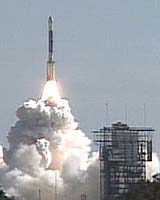Solar Sails fastest way to Mars?
Sunday, February 13, 2005

Photo from Space.com
I posted about this earlier on my site, but you might have heard about Gregory Benford, who is a professor of physics at UC Irvine as well as a notable science fiction author. Gregory, along with his brother James conducted an interesting experiment.
Dr. Benford and his brother James were testing a very thin carbon-mesh sail, using microwaves as the energy source for propulsion. Unexpectedly, the sail experienced a force considerably greater than predicted. They theorized that the heat from the microwave beam was causing carbon monoxide gas to escape from the sail's surface; the recoil from the escaping molecules provided what could be a useful adjunct to the propulsive force experienced by light sails.
They believe that by beaming microwave energy up from Earth to boil off volatile molecules from a specially formulated paint applied to the sail will provide enough added force to propel a spacecraft to Mars in record time. "It's a different way of thinking about propulsion," Gregory Benford says. "We leave the engine on the ground." Their research will be published this month in the journal Acta Astronautica.
I look forward towards the publication of this article. More from Space.com:
This is how it would work: a rocket would take the craft to low-Earth orbit, whereupon the craft would unfurl a 100 meter diameter sail. A transmitter on Earth would fire a one-hour burst of microwaves at it to heat it up, accelerating the craft to 60 kilometres per second. This would set an interplanetary speed record for space probes.
This might be an alternative to nuclear propulsion as that can not only be expensive but also dangerous (would you fly with a nuclear reactor strapped to your back?). The project has major undertakings though.
The plan would require a 60-megawatt microwave beam with a similar diameter as the sail that was capable of tracking the craft. The deep-space communications network that NASA uses to communicate with Mars rovers and the Cassini probe now orbiting Saturn can only output half a megawatt.
Constructing this would be a major task for NASA, but the prize could be far more rewarding than their pursuit of rocket or nuclear propulsion. Although this is a good idea, I would recommend that the "solar sail" be equipped with rockets (chemical or nuclear) in the event that they "sail off course" or in order to gain speed around a planet. Either way I congratulate the Benford brothers and look forward to their proposal towards the space community (and hopefully NASA's as well). Selah!)



